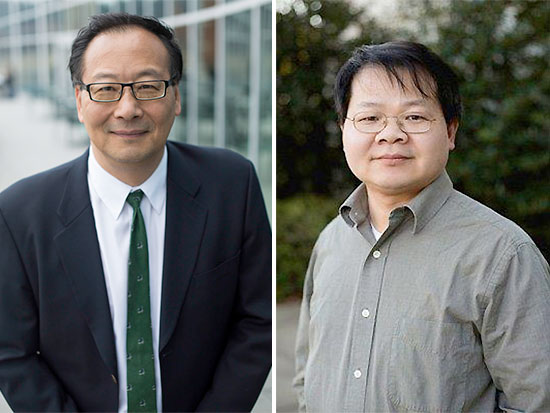 Jianyi “Jay” Zhang, M.D., Ph.D., left, and Wuqiang Zhu, M.D., Ph.D.While pigs still cannot fly, researchers have discovered that the hearts of newborn piglets do have one remarkable ability. They can almost completely heal themselves after experimental heart attacks.
Jianyi “Jay” Zhang, M.D., Ph.D., left, and Wuqiang Zhu, M.D., Ph.D.While pigs still cannot fly, researchers have discovered that the hearts of newborn piglets do have one remarkable ability. They can almost completely heal themselves after experimental heart attacks.
This regenerative capacity is short-lived — disappearing by day three after birth, say teams of researchers at the University of Alabama at Birmingham and at several institutions in Singapore. This is the first time the ability regrow heart muscle has been shown in large mammals, the two teams report in the journal Circulation.
This research has impactful clinical implications, says UAB researcher Jianyi “Jay” Zhang, M.D., Ph.D.
Although no study has ever assessed neonatal heart regeneration in humans, except a case study of one patient, there is evidence that surgical correction of anomalous coronary arteries in the first three months of life is associated with significant improvement of systolic function. Therefore, identifying a regenerative window in larger mammals is a crucial step towards understanding the human heart regenerative window, and may serve as a platform for future clinical studies in human infants afflicted by devastating heart conditions.
This could establish new guidelines for timing of pediatric heart surgery that benefit from the regenerative potential of the newborn human heart, help to design novel surgical techniques for pediatric heart surgery, and help develop new therapeutic modalities to enhance or prolong this regenerative window.
Most importantly, once we discover the mechanisms that underlie the drastic changes in neonatal cardiac cardiomyocyte proliferation during the first week of life, we may be able to manipulate this mechanisms to promote myocardial regeneration in injured hearts, not only in pediatric but also in adult patients.
The UAB research, led by Zhang and Wuqiang Zhu, M.D., Ph.D., found that 1-day-old piglets were able to functionally and structurally recover from experimental heart attacks, as measured by heart pumping ability, thickness of the heart muscle in the left ventricle and a near absence of fibrotic scar tissue. In contrast, 3-day-old piglets had significant functional and structural impairments and 2-day-old piglets showed only partial recovery.
| The UAB research, led by Zhang and Zhu, found that 1-day-old piglets were able to functionally and structurally recover from experimental heart attacks. |
They also found that cell cycle activity, as measured by a number of markers, was prolonged and heightened in the hearts of piglets that had experimental heart attacks at day one. Thus, it appeared that, in these newborn large mammals, the acute heart attack activated cell-cycle activity in surviving heart muscle cells, known as cardiomyocytes, and newly dividing cells then replaced dead cardiomyocytes lost during injury.
At UAB, Zhang is chair and professor of the UAB Department of Biomedical Engineering and holder of the T. Michael and Gillian Goodrich Endowed Chair of Engineering Leadership. Zhu is assistant professor of biomedical engineering.
The Singapore group was led by Lei Ye, M.D., Ph.D., and Stuart Cook, Ph.D., of the National Heart Research Institute Singapore, Singapore. Ye and Cook found results very similar to the UAB study, and many of the methods they used to gauge cardiomyocyte proliferation in the newborn piglet hearts after experimental heart attacks differed from the methods used by the UAB researchers, thus strengthening the conclusions of these independent studies. They showed that the injury in neonatal piglet hearts two days after birth was largely repaired, but that regenerative capacity was soon lost.
“Defining the signals and associated signaling pathways that abrogate this profound regenerative capacity in the developing large mammal heart are important topics for future study,” Ye and Cook write in their paper.
Ye and Cook noted that lower animals like newts and zebrafish can regenerate heart tissue throughout life, but the adult mammalian heart does not have the ability to replace heart tissue that is lost after heart attacks. Most of the growth of the mammalian heart after birth comes primarily through hypertrophy of existing cardiomyocytes, not through cell division.
Both groups at Singapore and UAB included RNA sequencing data to show differentially expressed genes in the regenerating hearts, and the Singapore team had a heatmap showing differential expression of fibrosis genes among the different experimental groups of piglets.
This research on the regenerative ability of hearts in newborn large mammals was started by Zhang and Ye four years ago, when Zhang was on the faculty at the University of Minnesota and Ye was his research associate. Both continued their research independently when Zhang moved to UAB and Ye moved to Singapore. Zhang is an author on both Circulation papers.
UAB co-authors with Zhang and Zhu in the Circulation paper, “Regenerative potential of neonatal porcine hearts,” are Eric Zhang, Meng Zhao, Chengming Fan, Yawen Tang, Jervaughn Hunter, Anton Borovjagin, Gregory Walcott and Gangjian Qin, UAB School of Medicine and School of Engineering; Zechen Chong, UAB Department of Genetics; and Jake Chen, UAB Informatics Institute.
Support for the UAB study came from National Institutes of Health grants HL95077, HL114120, HL131017, HL138023 and HL134764, and from American Heart Association Scientist Development Grant 16SDG30410018.
The Singapore study by Ye, Cook and colleagues, also published in Circulation, is titled “Early Regenerative Capacity in the Porcine Heart.”